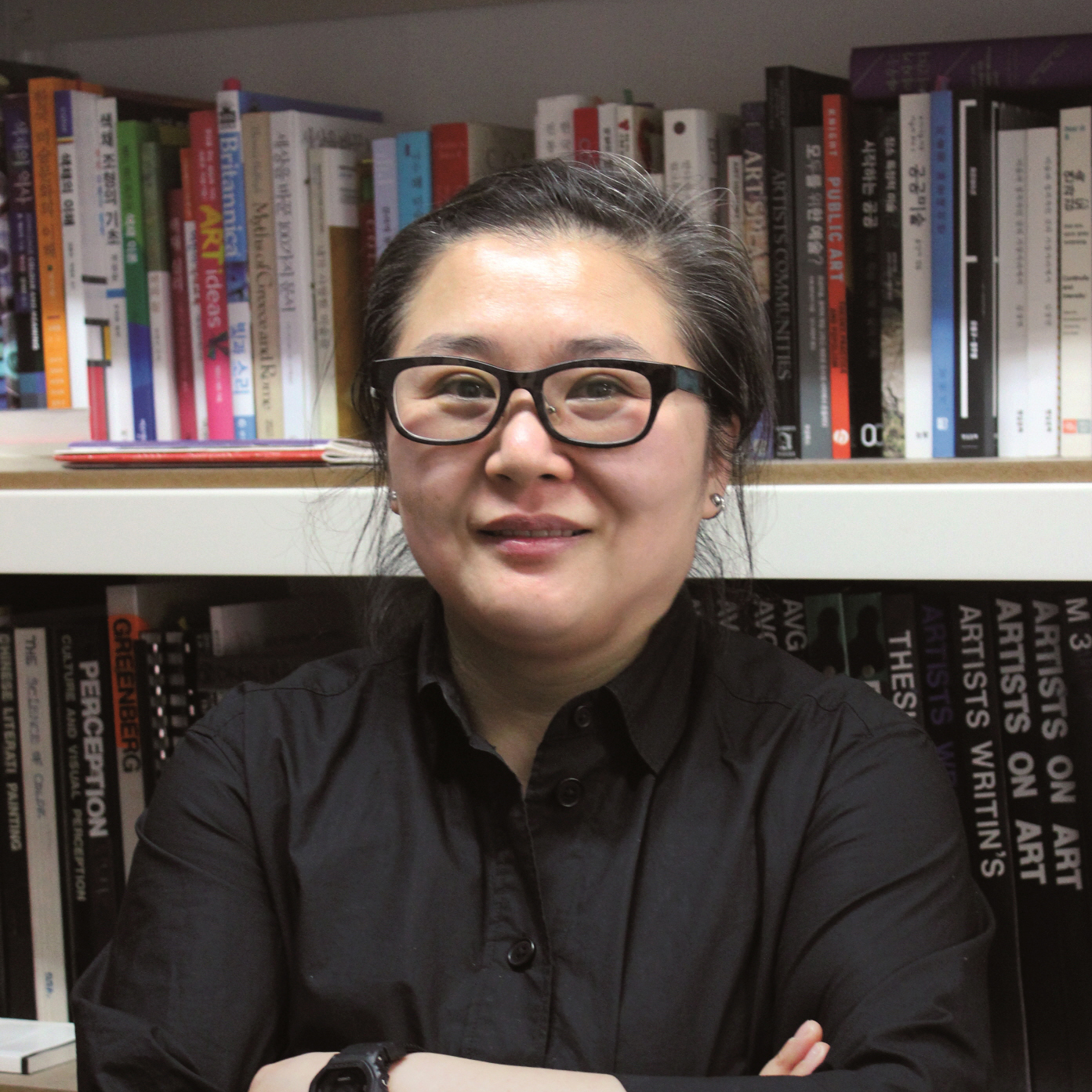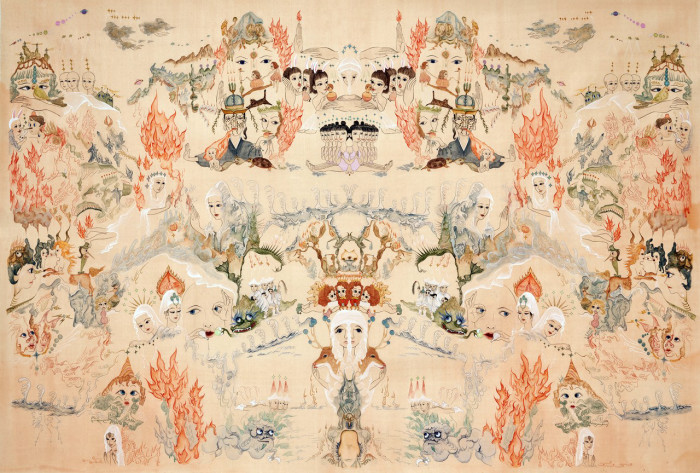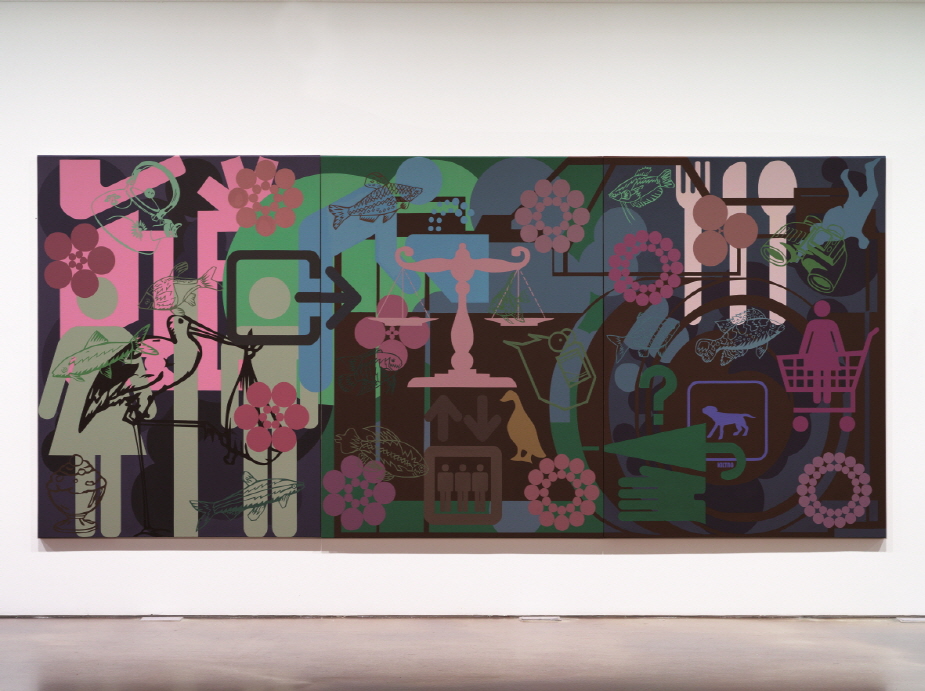MeeNa Park (b. 1973) has persistently
explored the production, distribution, and consumption methods and environments
related to color and form, which are fundamental elements of painting. Over the
past 20 years, she has collected commercially available paints and widely used
patterns, using them as part of a system to create her own distinctive
paintings.
 Installation
view of “Why rain drop overlapped blue faces golden bear at the circus?” (Audio
Visual Pavilion, 2020) ©Audio Visual Pavilion
Installation
view of “Why rain drop overlapped blue faces golden bear at the circus?” (Audio
Visual Pavilion, 2020) ©Audio Visual PavilionMeeNa
Park’s work begins with a focus on color. Her early piece Autumn Sky
(1995) involved using commercially available paint to replicate the colors she
perceived in the sky as closely as possible. To achieve this, she recorded the
color of the sky from the same place and at the same time every day for a
month, translating these observations onto her palette.

MeeNa Park, 5, 2011 ©DOOSAN Art Center
Since
1998, Park has become interested in children’s coloring books designed for
learning. Moving away from the conventional approach of filling in shapes
outlined on paper, she developed her own set of rules for applying color. Her Coloring
Exercise drawings series (1998–) involves collecting and categorizing
coloring books from various publishers featuring common icons like the moon or
sun, isolating these icons, and filling them with color in her unique style.
 MeeNa Park, 12
Colors Drawings II, 2013 ©Kukje Gallery
MeeNa Park, 12
Colors Drawings II, 2013 ©Kukje GalleryIn her 2013 coloring book work 12
Colors Drawings II, Park used learning coloring papers featuring
motifs of the sun, moon, and stars, filling them with systematic patterns using
12-color sets of colored pencils or mass-produced pencils from various
companies. This work explores the relationships between theme, form, and color,
showcasing the color spectrum of 12 basic colors along with black and gray.

MeeNa Park, Orange Painting, 2002 ©The Kyunghyang Shinmun
Later,
Park presented Orange Painting (2002-2003), a work that
involved collecting and researching all orange-toned paints available on the
market. She gathered these orange paints sold nationwide, organized them by
manufacturer, and painted them in uniform, horizontal lines on the canvas.
The
top of the filled canvas resembles a monochromatic painting with a horizontal
structure, while the bottom features an outline of a sofa, evoking the image of
a painting hung in a domestic interior behind a couch.
 MeeNa
Park, 2005 Coreana Lipstic, 2005 / 2005 Coreana Eye
Shadow, 2005, Installation view of “Cosmo Cosmetic” (Coreana Museum
of Art, 2005) ©Coreana Museum of Art
MeeNa
Park, 2005 Coreana Lipstic, 2005 / 2005 Coreana Eye
Shadow, 2005, Installation view of “Cosmo Cosmetic” (Coreana Museum
of Art, 2005) ©Coreana Museum of ArtThe artist's interest in commercially
available colors extended beyond paint. In the 2005 group exhibition “Cosmo
Cosmetic” at the Coreana Museum of Art, Park presented a work that involved
collecting and cataloging various colors found in cosmetics on paper.
She gathered all the lipsticks and
eyeshadows produced and distributed by Coreana at that time, organizing them by
color and name. This "color collection" project reflects a meticulous
and detailed process of researching, collecting, and analyzing all the colors
experienced in everyday life, where the artist’s personal subjectivity is
minimized, and only a symbolic system of color representation remains.

MeeNa Park, WwwFreshcopyrunntungddddfjMNMNPQEQ, 2008 ©DOOSAN Art Center
In her solo exhibition “Home Sweet
Home” at Project Space Sarubia in 2007, Park introduced her Dingbat
Paintings series, exploring the relationship between image and
language.
Dingbats are a form of communication
using simple images, icons, or symbols rather than standard characters like the
alphabet or Hangeul. When a dingbat font is typed on a computer, it generates
designated images instead of letters, creating a unique system of visual
representation.

MeeNa Park, 5'PIU;UVYQ, 2010 ©MeeNa Park
This work, which introduces dingbat
fonts as image-characters into a new pictorial language, combines specific
dingbat images and special fonts according to complex information, presenting
them in a simplified, symbolized format.
In Dingbat Paintings,
images as symbols are arranged and juxtaposed on the canvas, allowing for
various interpretations depending on the user’s intent or context. This
reflects a facet of contemporary visual culture, where the relationship between
signifier and signified is formed arbitrarily.
 MeeNa Park, Flowers
Scream, 2008 ©MeeNa Park
MeeNa Park, Flowers
Scream, 2008 ©MeeNa ParkAnother
of MeeNa Park's notable works, the Scream series
(2001–2019), examines arrangements and computations of color, form, content,
and structure based on icons and themes, revealing the industrial order of
paint itself. The series uses a cartoonish image of a figure seemingly
screaming with an exposed uvula as its basic framework, varying the
combinations of color and form.
 MeeNa Park, Green
Scream, 2019 ©Prompt Project
MeeNa Park, Green
Scream, 2019 ©Prompt ProjectUnlike
MeeNa Park's previous systematic and objective works, the Scream
series is an exceptional piece in which the artist's personal narrative is
subtly embedded. For each artwork, she envisions a different story and
diversifies the colors and forms, yet the specific content of these stories
remains largely undisclosed.
Park
compares Scream to a fugue in music, where a theme is
repeated at varying pitches; similarly, Scream continuously develops specific
elements, adding layers of meaning and narrative.
 MeeNa Park, 2014-Black,
2014, Installation view of “Black” (Perigee Gallery, 2024) ©Perigee Gallery.
Photo: Kim Sang-Tae
MeeNa Park, 2014-Black,
2014, Installation view of “Black” (Perigee Gallery, 2024) ©Perigee Gallery.
Photo: Kim Sang-TaeSince 2006, MeeNa Park has extended her
work of collecting, classifying, and documenting colors from the Orange
Painting series to include black, a neutral color unlike orange.
Following her established method, she gathered all commercially available black
pens and oil paints and organized them according to specific rules.
For instance, 2014-Black
(2014) involved collecting black oil paints on the market and filling each of
55 canvases, each measuring 27.3 x 27.3 cm, allowing for a comparison and
contrast between shades of black.
 MeeNa Park, Black
Pens, 2006-2024, Installation view of “Black” (Perigee Gallery, 2024)
©Perigee Gallery. Photo: Kim Sang-Tae
MeeNa Park, Black
Pens, 2006-2024, Installation view of “Black” (Perigee Gallery, 2024)
©Perigee Gallery. Photo: Kim Sang-TaeBlack
Pens (2006-2014) is a drawing series made with black ballpoint pens
from various manufacturers, featuring repeated lines on A4 paper at consistent
intervals. Each of the 498 drawings is labeled with the pen's brand and unique
identifier at the bottom, which the artist catalogs separately. This work
reveals not only differences in color but also variations in texture due to the
materials and thickness of the pen tips.
According
to the artist, when learning painting, they were taught to avoid using black
paint, which is typically categorized as a neutral color, and instead create
and use various shades by mixing different oil paints. This means that black,
made by blending various oil colors, will produce different shades of black
depending on the colors and proportions used. The artist's work challenges our
preconceived notions of black, which we have traditionally perceived as simply
a neutral color.
 MeeNa Park, 111122223333444556677888
999000AABBFGgJoVvWwx, 2012 ©MeeNa Park
MeeNa Park, 111122223333444556677888
999000AABBFGgJoVvWwx, 2012 ©MeeNa ParkIn this way, Park's work may initially appear as simple abstract painting with prominent graphic elements, but by recording facets of reality in the form of color and product shapes, she presents a new perspective on discerning the structure of social and cultural systems. The artist's methodology is regarded as a new critical alternative to the form of painting, as well as a sociological research of contemporary society.
“You need to know what the scope or rules are so you can choose whether to keep them or break them.” (MeeNa Park, Artist’s Note)
 Artist MeeNa Park
©Hermès Foundation
Artist MeeNa Park
©Hermès FoundationMeeNa
Park had her first solo exhibition at the Banson Hall Gallery in 1996 and made
her debut in the Korean art world with the group exhibition “Relay Relay” at
Insa Art Space in 2000. She held her first solo exhibition at Seoul Auction
House in 2002, the year she started making her name as the 4th artist of
Ssamzie Space Residency.
Her
recent solo exhibitions are including “Black” (Perigee Gallery, 2024), “House”
(ONE AND J. Gallery, 2023), “Nine Colors & Nine
Furniture” (Atelier Hermès, 2023), “Why rain drop overlapped blue faces golden
bear at the circus?” (Audio Visual Pavilion, 2022), and more.
Park has also participated in numerous
domestic and international group exhibitions at Seoul Museum of Art, Kumho
Museum of Art, PLATEAU Samsung Museum of Art, Gwangju Design Biennale, DOOSAN
Gallery (New York, USA), International Center for Contemporary Art (Rome,
Italy), etc. Her works are in the collections of Museum of Modern and
Contemporary Art Korea, Seoul Museum of Art, Leeum Samsung Museum of Art, Ilmin
Museum of Art, and more.
References
- K-ARTIST.COM, 박미나 (K-ARTIST.COM, Park Meena)
- 국제갤러리, Grey & 12 (Kukje Gallery, Grey & 12)
- 아뜰리에 에르메스, 아홉 개의 색, 아홉 개의 가구 (Atelier Hermès, Nine Colors & Nine Furniture)
- 두산아트센터, Gray Sky (DOOSAN Art Center, Gray Sky)
- 프로젝트 스페이스 사루비아, 홈 스위트 홈 (Project Space Sarubia, Home Sweet Home)
- 페리지갤러리, 검은 (Perigee Gallery, Black)




















